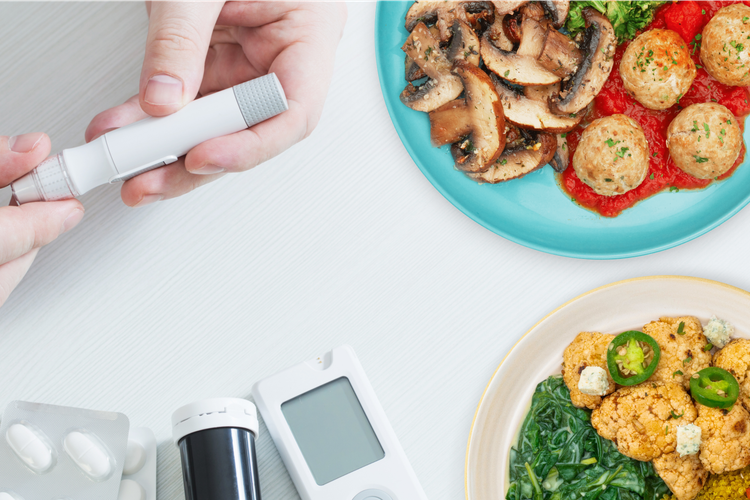
Diets
Lower A1C Naturally: Proven Strategies for Diabetes Management
Overview: Lowering A1C naturally is possible through diet, exercise, stress management, and lifestyle changes. Eating low-glycemic foods, staying active, and managing stress and sleep can improve blood sugar control and reduce A1C over time.
In diabetes management Hemoglobin A1c (HbA1c) is a key metric of long-term control. It reflects average blood sugar levels over the past two to three months, providing a comprehensive view of glycemic control.
For those seeking to lower A1c naturally, a combination of dietary changes, regular physical activity, weight management, stress reduction, adequate sleep, hydration, and professional support can make a significant difference.
To help with your diet, you can, of course, subscribe to a diabetic meal plan delivery services such as LifeChef!
Understanding A1C & Blood Sugar
A1c is a crucial marker for diabetes management, indicating how well blood sugar levels have been controlled over time. Maintaining healthy A1c levels (usually below 7% for most people with diabetes) is essential for reducing the risk of complications associated with high blood sugar.
Dietary Changes to Lower Your A1C
One of the most impactful ways to lower A1c and combat diabetes naturally is through dietary adjustments. Focus on incorporating high-fiber foods like whole grains, legumes, fruits, and vegetables into your meals. These foods slow down the absorption of sugar, preventing spikes in blood glucose levels.
Low glycemic index (GI) foods such as quinoa, sweet potatoes, and lentils have a gentler effect on blood sugar. Additionally, leafy greens like spinach, kale, and Swiss chard are beneficial for blood sugar control. Avoiding processed and sugary foods is also key to managing A1c levels effectively.
You can get more ideas about changing your diet with this diabetic food list.
Hydration Helps With Managing Blood Sugar
Staying adequately hydrated is important for blood sugar control and managing type 2 diabetes. Water helps transport glucose to cells, so aim to drink at least eight glasses of water per day. Skip sugary drinks and choose water, herbal teas, or infused water with fruits or herbs for added flavor.
Regular Exercise to Lower Your A1C
Exercise also is impactful in lowering A1c levels naturally. Both aerobic and strength training exercises can improve insulin sensitivity, which allows glucose to enter cells more effectively. Aim for at least 150 minutes of moderate-intensity aerobic activity along with two sessions of strength training, weekly.
According to the American Diabetes Association 150 minutes of moderate intensity exercise each week can significantly help manage diabetes and reduce the risk of developing diabetes in the first place. That amounts to 30 minutes of daily exercise, which can be achieved by small changes to your daily routine.
Simply taking the stairs and taking a brisk walk after meals contributes to better blood sugar control.
Weight Loss Goals for Diabetes
Maintaining a healthy weight is linked to diabetes management. Excess body weight, especially around the abdomen, can lead to insulin resistance and higher blood sugar levels. Aiming to reach your ideal weight will help lower A1c naturally.
Manage Diabetes — Manage Stress
Chronic stress can raise blood sugar levels through hormonal changes, making it essential to incorporate stress-reducing activities into your routine. Practices like meditation, yoga, deep breathing exercises, and mindfulness can help lower stress levels and improve blood sugar control naturally.
Adequate Sleep
Quality sleep is good for health, but also plays a role in blood sugar management. Aim for seven to nine hours of uninterrupted sleep each night and establish a consistent sleep schedule. Create a relaxing bedtime routine and optimize your sleep environment for better sleep and improved A1c levels. In addition to enhancing blood sugar control, quality sleep supports overall physical and mental well-being. A well-rested body is better equipped to manage stress, which can also impact blood sugar levels. To further optimize your sleep environment, consider the following tips:
Tips for Better Sleep
- Limit Exposure to Screens Before Bed: The blue light emitted by phones, tablets, and computers can interfere with your body’s natural sleep-wake cycle. Try to avoid screens at least an hour before bedtime.
- Maintain a Comfortable Sleep Environment: Ensure your bedroom is cool, dark, and quiet. Investing in a good-quality mattress and pillows can also make a significant difference in sleep quality.
- Be Mindful of Food and Drink: Avoid caffeine and heavy meals close to bedtime. If you’re hungry, opt for a light snack that won’t disrupt your sleep.
- Incorporate Relaxation Techniques: Activities such as reading, meditation, or gentle yoga can help calm your mind and prepare your body for sleep.
- Regular Physical Activity: Engaging in regular exercise can help regulate your sleep patterns. However, try not to exercise too close to bedtime as it may energize you and make it harder to fall asleep.
- Monitor Sleep Patterns: Keep track of your sleep quality and duration, and make adjustments to your habits as needed.
By prioritizing quality sleep, you can enhance not only your blood sugar management but also your overall health and vitality. Remember that sleep is a crucial component of a healthy lifestyle, and making it a priority can lead to significant long-term benefits.
Regular Blood Sugar Monitoring
Regular monitoring of blood sugar levels, as well as seeking support from healthcare providers is crucial for managing A1c levels effectively.
Taking a holistic approach is the best way to lower A1c levels naturally; through diet, exercise, stress management, sleep, hydration, and professional support you can meet your goals.
You can also measure A1C directly. An A1C test measures the amount of hemoglobin with attached glucose and can give you a clear picture of your blood glucose levels over the past 3 months.
Ready to take the next step in lowering your A1c levels naturally?
Book a consultation with our experienced nutritionist today for personalized advice and support on your journey to better health. Together, we can create a tailored plan that fits your unique needs and helps you achieve optimal blood sugar control. Don’t wait—start your journey towards healthier living today!
Frequently Asked Questions
What is an A1C test and why is it important?
An A1C test, also known as the hemoglobin A1C test, is a blood test that measures your average blood sugar levels over the past two to three months. It specifically measures the percentage of hemoglobin in your red blood cells that is coated with blood sugar. This test is crucial for diagnosing and managing diabetes or prediabetes because it provides an overview of how well you are controlling your blood sugar over time. Maintaining a healthy A1C level can lower your risk of complications such as heart disease and nerve damage.
How can lifestyle changes help lower A1C levels naturally?
Implementing lifestyle changes is a highly effective way to lower A1C levels naturally. This includes maintaining a healthy weight, engaging in regular physical activity, and adopting a balanced diet. Regular exercise helps improve insulin sensitivity, allowing your cells to use blood glucose more efficiently, which can lower your blood sugar. A diet rich in whole grains, vegetables, and lean protein can help manage your blood sugar levels and support overall well-being.
What dietary changes can help lower A1C levels naturally?
To lower A1C levels naturally, focus on incorporating foods that have a low glycemic index, as they have a minimal impact on blood sugar levels. Choose whole grain options over refined carbohydrates, and include plenty of fruits, vegetables, and lean protein in your meals. Reducing intake of sugary foods and drinks can also help lower your blood sugar. Additionally, eating smaller, more frequent meals can help maintain stable blood sugar throughout the day.
How does regular physical activity contribute to lowering A1C levels?
Engaging in regular physical activity is key to lowering A1C levels.



